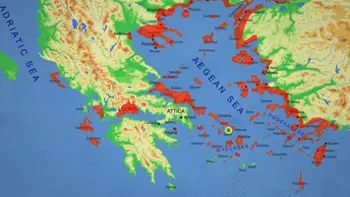The Delian League
The Greek victory over Persian forces at the Battle of Plataea (479 B.C.) ended the Persian invasion of Greece, but it didn't reduce the Persian armed forces to rubble. The very next year, a large number of Greek city-states banded together to form the Delian League, an ancient mutual protection society. 
Athens was the largest member of the League, which was named for the island on which meetings took place, Delos. About 150 city-states and island colonies in and around the Aegean made up the League. Athens took a leading role in decision-making and actions of the League, so much so that in 454 B.C., Athens' famed "First Citizen" Pericles moved the League's meeting place and treasury to Athens. This action cemented the path to empire that had begun in 472 B.C., when a city in Euboea, Carystus, refused to join the League and found itself occupied by Athenian troops. Then, in 467 B.C., Athens insisted that Naxos could not secede from the League and attacked it to keep it in the fold; in similar fashion, two years later, Athens punished Thasos for trying to withhold some of its mining operations by laying siege to the city, resulting in surrender by Thasos after three years. Sparta had a similar grouping of alliances with other city-states, called the Peloponnesian League. In 460 B.C., the two Leagues went to war with each other; the resulting conflict lasted 15 years. During that time, Athens had also championed a Delian League expedition into Egypt, which resulted in a Greek defeat; it was this disaster that Pericles used as a pretext for moving the League headquarters to Athens. Athens had almost from the first conducted naval maneuvers with ships that technically belonged to the League. At one point, Athens took all of the League treasury and spent it on Athenian ships and on rebuilding projects within Athens. This and other examples of Athenians pre-eminence led to the League's evolving into the Athenian Empire and to a reaction of a military nature by Sparta. The Second Peloponnesian War began in 431 B.C. Sparta's victory in that war, in 404 B.C., effectively ended the Delian League. The League was by no means only a military alliance. At its height, it included more than 200 members, who traded with one another and used a common currency, an Athenian tetradrachm. Also centralized were systems of taxation and of weights and measures.
|
|
Social Studies for Kids
copyright 2002–2025
David White




